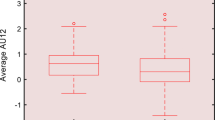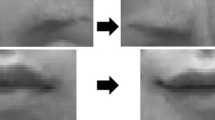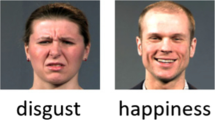Abstract
Research shows that neurotypical individuals struggle to interpret the emotional facial expressions of people with Autism Spectrum Disorder (ASD). The current study uses motion-capture to objectively quantify differences between the movement patterns of emotional facial expressions of individuals with and without ASD. Participants volitionally mimicked emotional expressions while wearing facial markers. Recorded marker movement was grouped by expression valence and intensity. We used Growth Curve Analysis to test whether movement patterns were predictable by expression type and participant group. Results show significant interactions between expression type and group, and little effect of emotion valence on ASD expressions. Together, results support perceptions that expressions of individuals with ASD are different from—and more ambiguous than—those of neurotypical individuals’.







Similar content being viewed by others
References
Arsalidou, M., Morris, D., & Taylor, M. J. (2011). Converging evidence for the advantage of dynamic facial expressions. Brain Topography, 24(2), 149–163. https://doi.org/10.1007/s10548-011-0171-4.
Association, A. P. (2013). Diagnostic and statistical manual of mental disorders (5th edn.). Washington DC: American Psychiatric Association.
Baron-Cohen, S., & Kingsley, J. (2003). Mind reading: The interactive guide to emotions. London: Jessica Kingsley Publisher
Beall, P. M., Moody, E. J., McIntosh, D. N., Hepburn, S. L., & Reed, C. L. (2008). Rapid facial reactions to emotional facial expressions in typically developing children and children with autism spectrum disorder. Journal of Experimental Child Psychology, 101(3), 206–223. https://doi.org/10.1016/j.jecp.2008.04.004.
Bone, D., Mertens, J., Zane, E., Lee, S., Narayanan, S., & Grossman, R. (2017). Acoustic-prosodic and physiological response to stressful interactions in children with autism spectrum disorder. In Proceedings of the Annual Conference of the International Speech Communication Association, INTERSPEECH (Vol. 2017). https://doi.org/10.21437/Interspeech.2017-179.
Bonneh, Y. S., Levanon, Y., Dean-Pardo, O., Lossos, L., & Adini, Y. (2011). Abnormal speech spectrum and increased pitch variability in young autistic children. Frontiers in Human Neuroscience, 4, 237. https://doi.org/10.3389/fnhum.2010.00237.
Brewer, R., Biotti, F., Catmur, C., Press, C., Happé, F., Cook, R., & Bird, G. (2016). Can neurotypical individuals read autistic facial expressions? Atypical Production of emotional facial expressions in autism spectrum disorders. Autism Research, 9(2), 262–271. https://doi.org/10.1002/aur.1508.
David, F. J., Baranek, G. T., Giuliani, C. A., Mercer, V. S., Poe, M. D., & Thorpe, D. E. (2009). A pilot study: Coordination of precision grip in children and adolescents with high functioning autism. Pediatric Physical Therapy, 21(2), 205–211. https://doi.org/10.1097/PEP.0b013e3181a3afc2.
Ekman, P. (2004). Emotional and conversational nonverbal signals. Language, Knowledge, and Representation. https://doi.org/10.1093/acprof.
Ekman, P., & Friesen, W. (1971). Constants across cultures in the face and emotion. Journal of Personality and Social Psychology, 17(2), 124.
Ekman, P., & Friesen, W. (1977). Facial action coding system. Palo Alto: Consulting Pscyhologists Press, Stanford University.
Ekman, P., & Friesen, W. V. (1978). The facial action coding system: A technique for the measurement of facial movement. Palo Alto, CA: Consulting Psychologists Press.
Faso, D. J., Sasson, N. J., & Pinkham, A. E. (2015). Evaluating Posed and evoked facial expressions of emotion from adults with autism spectrum disorder. Journal of Autism and Developmental Disorders, 45(1), 75–89. https://doi.org/10.1007/s10803-014-2194-7.
Fournier, K. A., Hass, C. J., Naik, S. K., Lodha, N., & Cauraugh, J. H. (2010). Motor coordination in autism spectrum disorders: A synthesis and meta-analysis. Journal of Autism and Developmental Disorders, 40(10), 1227–1240. https://doi.org/10.1007/s10803-010-0981-3.
Grossman, R. B. (2015). Judgments of social awkwardness from brief exposure to children with and without high-functioning autism. Autism: The International Journal of Research and Practice, 19(5), 580–587. https://doi.org/10.1177/1362361314536937.
Grossman, R. B., Edelson, L. R., & Tager-Flusberg, H. (2013). Emotional facial and vocal expressions during story retelling by children and adolescents with high-functioning autism. Journal of Speech, Language, and Hearing Research, 56(June 2013), 1035–1044. https://doi.org/10.1044/1092-4388(2012/12-0067)Journal.
Guha, T., Yang, Z., Grossman, R. B., & Narayanan, S. S. (2016). A computational study of expressive facial dynamics in children with autism. IEEE Transactions on Affective Computing, 1–1. https://doi.org/10.1109/TAFFC.2016.2578316.
Guha, T., Yang, Z., Ramakrishna, A., Grossman, R. B., Hedley, D., Lee, S., & Narayanan, S. S. (2015). On quantifying facial expression-related atypicality of children with Autism Spectrum Disorder. In ICASSP, IEEE International Conference on Acoustics, Speech and Signal Processing - Proceedings 2015, 803–807. https://doi.org/10.1109/ICASSP.2015.7178080.
Hallett, M., Lebiedowska, M. K., Thomas, S. L., Stanhope, S. J., Denckla, M. B., & Rumsey, J. (1993). Locomotion of autistic adults. Archives of Neurology, 50(12), 1304–1308.
Hauck, D. J., J (2007). House of moves high resolution facial merker-set (92 markers). Los Angeles: Digital Concepts Group, Inc. House of Moves.
Izard, C. (1983). The maximally discriminative facial movement coding system. Newark: University of Delaware, Instructional Resource Center.
Izard, C. E., Huebner, R. R., Risser, D., & Dougherty, L. (1980). The young infant’s ability to produce discrete emotion expressions. Developmental Psychology, 16(2), 132–140. https://doi.org/10.1037/0012-1649.16.2.132.
Kasari, C., Sigman, M., Mundy, P., & Yirmiya, N. (1990). Affective sharing in the context of joint attention interactions of normal, autistic, and mentally retarded children. Journal of Autism and Developmental Disorders, 20(1), 87–100.
Kasari, C., Sigman, M., & Yirmiya, N. (1993). Focused and social attention of autistic children in interactions with familiar and unfamiliar adults: A comparison of autistic, mentally retarded, and normal children. Development and Psychopathology, 5(3), 403–414. https://doi.org/10.1017/S0954579400004491.
Kring, A. M., & Sloan, D. M. (2007). The facial expression coding system (FACES): development, validation, and utility. Psychological Assessment, 19(2), 210–224. https://doi.org/10.1037/1040-3590.19.2.210.
Langdell, T. (1981). Face perception: An approach to the study of autism. London: Universtity of London.
Lau, S. (1982). The effect of smiling on person perception. Journal of Social Psychology. https://doi.org/10.1080/00224545.1982.9713408.
Leary, M. R., & Hill, D. a. (1996). Moving on: Autism and movement disturbance. Mental Retardation, 34(1), 39–53.
Lord, C., DiLavore, P. C., Gotham, K., Guthrie, W., Luyster, R. J., Risi, S., & Rutter, M. (2012). Autism diagnostic observation schedule: ADOS-2. Los Angeles: Western Psychological Services.
Lord, C., Risi, S., Lambrecht, L., Cook, E. H. J., Leventhal, B. L., DiLavore, P. C., … Rutter, M. (2000). The autism diagnostic schedule—generic: A standard measures of social and communication deficits associated with the spectrum of autism. Journal of Autism and Developmental Disorders, 30(3), 205–223. https://doi.org/10.1023/A:1005592401947.
Love, S. R. (1993). Recognition and Production of Facial Emotion by Autistic Children. Louisiana State University. Retrieved from http://digitalcommons.lsu.edu/gradschool_disstheses.
Matsugu, M., Mori, K., Mitari, Y., & Kaneda, Y. (2003). Subject independent facial expression recognition with robust face detection using a convolutional neural network. Neural Networks, 16, 555–559. https://doi.org/10.1016/S0893-6080(03)00115-1.
Matsumoto, D., & Lee, M. (1993). Consciousness, Volition, and the neuropsychology of facial expressions of emotion. Consciousness and Cognition, 2, 237–254. https://doi.org/10.1006/ccog.1993.1022.
McIntosh, D. N., Reichmann-Decker, A., Winkielman, P., & Wilbarger, J. L. (2006). When the social mirror breaks: Deficits in automatic, but not voluntary, mimicry of emotional facial expressions in autism. Developmental Science, 9(3), 295–302. https://doi.org/10.1111/j.1467-7687.2006.00492.x.
Metallinou, A., Grossman, R. B., & Narayanan, S. (2013). Quantifiying atypicality in affective facial expressions of children with autism spectrum disorders.
Ming, X., Brimacombe, M., & Wagner, G. C. (2007). Prevalence of motor impairment in autism spectrum disorders. Brain and Development, 29(9), 565–570. https://doi.org/10.1016/j.braindev.2007.03.002.
Mirman, D. (2014). Growth Curve Analysis and Visualization Using R, 168.
Mirman, D., Dixon, J. A., & Magnuson, J. S. (2008). Statistical and computational models of the visual world paradigm: Growth curves and individual differences. Journal of Memory and Language, 59(4), 475–494. https://doi.org/10.1016/j.jml.2007.11.006.
Nadig, A., & Shaw, H. (2012). Acoustic and perceptual measurement of expressive prosody in high-functioning autism: Increased pitch range and what it means to listeners. Journal of Autism and Developmental Disorders, 42(4), 499–511.
Nadig, A., Vivanti, G., & Ozonoff, S. (2009). Adaptation of object descriptions to a partner under increasing communicative demands: A comparison of children with and without autism. Autism Research, 2(6), 334–347. https://doi.org/10.1002/aur.102.
Oberman, L. M., Winkielman, P., & Ramachandran, V. S. (2009). Slow echo: Facial EMG evidence for the delay of spontaneous, but not voluntary, emotional mimicry in children with autism spectrum disorders. Developmental Science, 12(4), 510–520. https://doi.org/10.1111/j.1467-7687.2008.00796.x.
Otta, E., Lira, B. B. P., Delevati, N. M., Cesar, O. P., & Pires, C. S. G. (1994). The effect of smiling and of head tilting on person perception. Journal of Psychology: Interdisciplinary and Applied. https://doi.org/10.1080/00223980.1994.9712736.
Rinn, W. E. (1984). The neuropsychology of facial expression: A review of the neurological and psychological mechanisms for producing facial expressions. Psychological Bulletin, 95(1), 52–77. https://doi.org/10.1037/0033-2909.95.1.52.
Rozga, A., King, T. Z., Vuduc, R. W., & Robins, D. L. (2013). Undifferentiated facial electromyography responses to dynamic, audio-visual emotion displays in individuals with autism spectrum disorders. Developmental Science, 16(4), 499–514. https://doi.org/10.1111/desc.12062.
Sasson, N. J., Faso, D. J., Nugent, J., Lovell, S., Kennedy, D. P., & Grossman, R. B. (2017). Neurotypical peers are less willing to interact with those with autism based on thin slice judgments. London: Nature Publishing Group.
Scharlemann, J. P., Eckel, C. C., Kacelnik, A., & Wilson, R. K. (2001). The value of a smile: Game theory with a human face. Journal of Economic Psychology, 22, 617–640.
Stagg, S. D., Slavny, R., Hand, C., Cardoso, A., & Smith, P. (2014). Does facial expressivity count? How typically developing children respond initially to children with autism. Autism, 18(6), 704–711. https://doi.org/10.1177/1362361313492392.
Trotman, C. A., Faraway, J. J., Silvester, K. T., Greenlee, G. M., & Johnston, L. E. (1998). Sensitivity of a method for the analysis of facial mobility. I. Vector of displacement. Cleft Palate-Craniofacial Journal, 35(2), 132–141. https://doi.org/10.1597/1545-1569(1998)035%3C0132:SOAMFT%3E2.3.CO;2
Uono, S., Sato, W., & Toichi, M. (2010). Brief report: Representational momentum for dynamic facial expressions in pervasive developmental disorder. Journal of Autism and Developmental Disorders, 40(3), 371–377. https://doi.org/10.1007/s10803-009-0870-9.
Yan, W. J., Wu, Q., Liang, J., Chen, Y. H., & Fu, X. (2013). How fast are the leaked facial expressions: The duration of micro-expressions. Journal of Nonverbal Behavior, 37(4), 217–230. https://doi.org/10.1007/s10919-013-0159-8.
Yirmiya, N., Kasari, C., Sigman, M., & Mundy, P. (1989). Facial expressions of affect in autistic, mentally retarded and normal children. Journal of Child Psychology and Psychiatry and Allied Disciplines, 30(5), 725–735. https://doi.org/10.1111/j.1469-7610.1989.tb00785.x.
Yoshimura, S., Sato, W., Uono, S., & Toichi, M. (2015). Impaired overt facial mimicry in response to dynamic facial expressions in high-functioning autism spectrum disorders. Journal of Autism and Developmental Disorders, 45(5), 1318–1328.
Zane, E., Neumeyer, K., Mertens, J., Chugg, A., & Grossman, R. B. (2017). I think we’re alone now: Solitary social behaviors in adolescents with autism spectrum disorder. Journal of Abnormal Child Psychology. https://doi.org/10.1007/s10802-017-0351-0.
Acknowledgments
We are grateful to all the families who participated in this research. Research was supported by the NIH (NIDCD), Grant number 1R01DC012774-01, Grossman PI. We are also grateful to Dr. Darrin Rogers, of SUNY Fredonia, for offering statistical consultation.
Funding
This study was funded by the NIH (NIDCD), Grant Number 1R01DC012774-01.
Author information
Authors and Affiliations
Contributions
The first author helped to conceive and design the analysis; she collected data for the stimulus-categorization study; she performed the analysis, created the figures, and wrote the paper. The second author contributed data and analysis tools, and performed data processing, such as normalizing motion capture data and calculating distances between markers. The third author helped to conceive and design the analysis, and provided tools for performing it. The fourth author contributed analysis tools and techniques, along with data-processing techniques. The fifth author contributed to the design of the methods and oversaw data processing. The last author conceived the study design, oversaw motion-capture data collection, oversaw motion-capture pre-processing, and edited the paper.
Corresponding author
Ethics declarations
Conflict of interest
All authors declared that they have no conflict of interest.
Ethical Approval
All procedures performed in studies involving human participants were in accordance with the ethical standards of the institutional and/or national research committee and with the 1964 Helsinki declaration and its later amendments or comparable ethical standards.
Informed Consent
Informed consent or assent (for participants under the age of 12) was obtained from all individual participants who were included in the study, and informed consent was obtained from all participants’ caregivers.
Rights and permissions
About this article
Cite this article
Zane, E., Yang, Z., Pozzan, L. et al. Motion-Capture Patterns of Voluntarily Mimicked Dynamic Facial Expressions in Children and Adolescents With and Without ASD. J Autism Dev Disord 49, 1062–1079 (2019). https://doi.org/10.1007/s10803-018-3811-7
Published:
Issue Date:
DOI: https://doi.org/10.1007/s10803-018-3811-7




